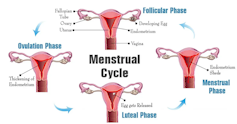"When was your last period?"
Authors
Evelina Sterling
Associate Professor of Medical Sociology, Kennesaw State University
Margaret Louisa Stubbs
Professor Emerita of Psychology, Retired, Chatham University
For anyone who menstruates, this is a routine question during any visit to your doctor.
Health care providers generally ask this to determine whether their patient is concerned about a menstrual problem, or a possible pregnancy, or whether menopause is approaching or has occurred.
But rarely is the question discussed in the context of exploring menstrual experience as a "vital sign of health" throughout life. In fact, many providers fail to recognize the fundamental role of the menstrual cycle in overall health.
Menstrual experiences throughout the reproductive years and beyond can offer critical insights into a person's overall well-being, akin to blood pressure, body temperature and heart rate.
We are a medical sociologist and public health researcher who focuses on women's health issues and a professor emerita of psychology who has studied menstrual experiences across the life span and worked to improve menstrual education and body literacy.
Although it may seem as though the menstrual cycle's main role is to facilitate pregnancy, this is only part of its purpose. In fact, it is a cornerstone of overall health and well-being thoughout the reproductive years and into the menopausal transition.
Understanding the menstrual cycle
The menstrual cycle, or period, is a term that describes the sequence of events that occurs in the body that prepares for the possibility of pregnancy each month. It is measured from the time of the first day of menstruation until the first day of your next menstruation.
Although cycles vary, the overall menstrual process is the same for everyone. The menstrual cycle typically lasts about 28 days, but menstrual cycles ranging from 24 to 38 days are usually considered healthy. Cycles that do not regularly fall within this range should be further investigated for any underlying causes.

The menstrual cycle involves specific hormonal changes and physiological processes and comprises four main phases:
Menstruation: This is the shedding of the uterine lining, occurring if pregnancy does not happen. Bleeding usually lasts for two to seven days but can vary month to month and across an individual's life span. However, if bleeding tends to be outside of this range, especially month after month, underlying causes should be considered. The total amount of blood lost during one period is usually about 60 milliliters (about 2 ounces), although it can feel like a lot more at times. At that rate of bleeding, it takes about four hours for a regular tampon or pad to become fully soaked.
Follicular phase: Ovarian follicles grow, stimulated by follicle-stimulating hormone, preparing for ovulation.

Ovulation: Mid-cycle, a surge in luteinizing hormone triggers the release of a mature egg from the ovary, which allows the body to be ready for potential fertilization. If fertilization occurs, a pregnancy begins.
Luteal phase: Post-ovulation, the follicle transforms into the corpus luteum, producing progesterone to support a potential pregnancy.
The menstrual cycle as a vital sign
Regular menstrual cycles can indicate balanced hormone levels and reproductive health. Regular cycles are associated with better bone density, cardiovascular health and mental well-being.
Irregularities in the menstrual cycle include changes in cycle length, intensity of flow or other negative period-related changes, such as cramping - also called dysmenorrhea - or painful periods, breast tenderness, fatigue or negative mood changes. These irregularities can signal underlying issues such as polycystic ovary syndrome, which can also be a precursor to diabetes, primary ovarian insufficiency or endometriosis.
Irregular menstrual cycles can also lead to osteoperosis or indicate thyroid disease or reproductive organ abnormalities. In turn, these can affect fertility and overall quality of life.
Unusually heavy bleeding might suggest conditions such as fibroids, endometriosis or certain endocrine-related tumors. Absent periods could signal hormonal imbalances or problematic lifestyle factors, such as exercise-induced amenorrhea - meaning lack of periods - or eating disorders such as anorexia and bulimia.
In fact, some female athletes experience a condition called the female athlete triad, in which their training regimen leads to a combination of disordered eating, the absence of a menstrual cycle and loss of bone density. Missed periods, also called amenorrhea, are usually the first sign of trouble. If left unaddressed, they can lead to more serious lifelong conditions such as osteoporosis and infertility.
Starting the conversation early
Menarche, or a girl's first period, usually occurs around age 12. The Centers for Disease Control and Prevention states that the average age of menarche is 11.9 years old, with some starting as early as 8 years old and others as late as 16. An earlier onset of menstruation can be affected by an interaction of ethnicity, socioeconomic status and being overweight due to an unhealthy diet.
Overall, girls are getting their first periods earlier than in previous decades, although no one knows exactly why.
For nearly two decades, the American College of Obstetricians and Gynecologists and the American Academy of Pediatrics have advocated that health care practitioners consider girls' early menstrual experiences as a vital sign that may indicate healthy or problematic development.
For this reason, these organizations have urged clinicians to inform parents or caretakers about what is physically normal about early menstrual experiences. This allows parents and girls to know what to expect and to recognize abnormalities that need to be further explored.
Learning about menstruation as a vital sign of health can give girls a more positive foundation for later in life when they begin to understand and think of themselves as sexual beings.
Early negative messaging about menstruation is featured prominently in books for young girls, and this does not serve them well as they begin to come into their own sexuality. In fact, research shows that girls who feel negatively about their bodies, including not being comfortable with their menstrual cycle, have less agency in some sexual situations.
One recent study of girls found most would rather take medication to stop their period altogether than continue to experience healthy menstrual cycles. Early discussions of menstruation with health care providers and caretakers can combat such negative societal attitudes, enduring stigma and cultural taboos around menstruation.
Beyond adolescence
Of course, discussions about the menstrual cycle as a source of critical health information should not stop in adolescence. After all, the average person who menstruates experiences 450 periods in their lifetime.
Researchers studying the menstrual experiences of mature adults found that hormonal changes on the path to menopause can occur before menstrual bleeding changes, sometimes in the 30s and 40s. This can affect sleep, mood and more, making attention to menstrual health even more critical.
And while much of the existing research about the menstrual cycle as a vital sign has focused on girls and women, some health care professionals who understand the critical role of menstrual health are pointing out the great need for more attention to the experiences of gender-diverse people.
Being proactive
It is critical for anyone who menstruates to know the facts about menstruation throughout their entire life.
Cycle tracking at all ages can help identify symptom patterns, both physical and mental. This is especially important for those approaching menopause and even after menopause.
When you go to the doctor, don't be afraid to ask questions or bring attention to any changes or concerns. Continue the conversation beyond just providing the date of your last period.
![]()
The authors do not work for, consult, own shares in or receive funding from any company or organization that would benefit from this article, and have disclosed no relevant affiliations beyond their academic appointment.






